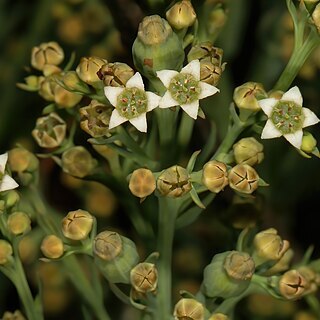Hemiparasitic shrub, 0.05-0.60 m high; from an erect rootstock, stems branched in upper part, closely sulcate. Leaves linear, 1.7-5.0 mm long, ± coarsely verrucose, somewhat fleshy, glabrous. Inflorescences of single or few-flowered cymes, arranged in loose, terminal panicles. Bracts leaf-like, adnate to peduncle for ± halfway. Flowers white, green-yellow. Perianth 1.5-2.0 mm long, tube present; segments broadly ovate, up to 1.3 mm long, hooded, margins slightly fringed, incurved, membranous. Flowering time Sept.-May. Fruit ellipsoid, up to 5 mm long, including persistent perianth; prominently 10-ribbed, reticulate between ribs.
Perennial herb, dwarf shrub or shrub, 0.05-0.60 m high. Stems few, erect, branched in upper part, closely sulcate, glabrous. Leaves somewhat fleshy; blade linear, 1.5-3.0 x 1.4 mm, coarsely verrucose. Flowers: in axillary cymules, arranged in many-flowered heads, spikes, racemes or panicles; bracts adnate to peduncle for half their length, leaf-like, longer than flowers; perianth not bearded, 1.5-2.0 mm long, segments 1.0-1.5 mm long, broadly ovate, hooded, margins slightly fringed, incurved, membranous, white; Oct.-Dec. Fruit ellipsoid, segments 5 mm long, prominently ribbed, coarsely reticulate, slightly shining.
Bushy herb, up to 400 mm tall. Stems slightly ribbed. Leaves and bracts rounded on back. Inflorescence several-flowered. Flowers white.

